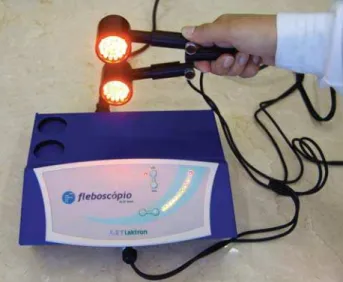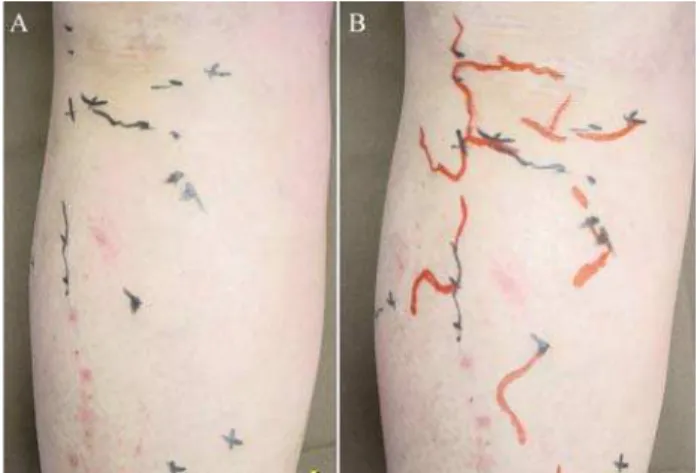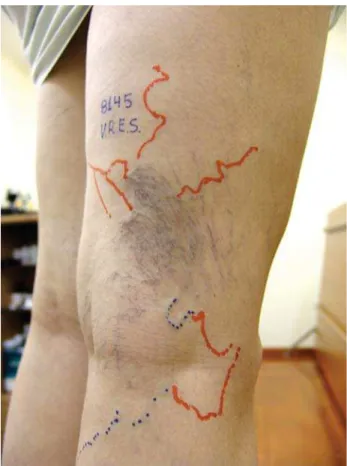The role of transillumination phleboscopy in the
planning of cosmetic operations for varicose veins
O papel da fleboscopia por transiluminação no planejamento de
cirurgias estéticas de varizes
Ricardo C. Rocha Moreira,
1Márcio Miyamotto,
2Ramzi Abdallah El-Hosni Jr.,
3Barbara D’Agnoluzzo Moreira
4313
J Vasc Bras. 2009;8(4):313-317.
Copyright © 2009 by Sociedade Brasileira de Angiologia e de Cirurgia Vascular
1. Chefe, Serviço de Cirurgia Vascular Prof. Dr. Elias Abrão, Hospital Nossa Senhora da Graças (HNSG) e Hospital Universitário Cajuru, Pontifícia Universidade Católica do Paraná (PUCPR), Curitiba, PR, Brazil.
2. Cirurgião vascular e endovascular, Serviço de Cirurgia Vascular Prof. Dr. Elias Abrão, HNSG e Hospital Universitário Cajuru, PUCPR, Curitiba, PR, Brazil. 3. Cirurgião vascular, Hospital Evangélico de Londrina, Londrina PR, Brazil.
4. Ex-residente, Cirurgia Vascular, Hospital Universitário Cajuru, PUCPR, Curitiba, PR, Brazil. Clinical Fellow, Vascular Surgery, Wayne State University, Detroit, MI, USA.
The present study was carried out at Serviço de Cirurgia Vascular Prof. Dr. Elias Abrão, Hospital Nossa Senhora das Graças, and Hospital Universitário Cajuru, Pontifícia Universidade Católica do Paraná, Curitiba, PR, Brazil.
Conflicts of interest: Ramzi Abdallah El-Hosni Jr. holds the patent on transillumination phleboscopy in Brazil. Manuscript received May 12 2009, accepted for publication Nov 9 2009.
Abstract
Background:The cosmetic treatment of varicose veins is the main activity of most vascular surgeons in Brazil. In order to obtain satisfac-tory cosmetic results, careful planning of varicose vein operations is nec-essary.
Objective:Marking (or “mapping”) the varicose veins with indeli-ble ink is an essential step in planning cosmetic surgeries for lower limb varicose veins. In the present study, the role of transcutaneous phle-boscopy (TcPh) in planning varicose vein operations is evaluated.
Methods:A series of 100 consecutive patients, all female, were evaluated with TcPH as part of their varicose vein operations planning. A total of 171 limbs with varicose veins (71 bilateral and 29 unilateral) were evaluated. The process of marking the varicose veins followed the same protocol in all cases. Firstly, the varicose veins were marked by inspec-tion and palpainspec-tion, with the patient standing, using an indelible black ink pen. Secondly, with the patients resting in supine and prone positions, the varicose veins detected with TcPh were marked again with red or blue ink. The marks made by the two methods were then compared.
Results:In 41 patients, for a total of 80 limbs (46.8%), the marks were altered after use of TcPh. Reasons for such changes were: 1) identi-fication of other varicose veins; 2) identiidenti-fication of reticular veins drain-ing complex telangiectasias; and 3) changes in the position of the marks placed with the patient standing.
Conclusions:TcPh has altered the planning of varicose vein sur-geries in 46.8% of all limbs evaluated, especially when the patients had complex telangiectasias, associated with reticular varicose veins.
Keywords:Varicose veins, surgical diagnostic techniques, vascu-lar surgery.
Resumo
Contexto:O tratamento estético de varizes é a principal atividade da maioria dos cirurgiões vasculares do Brasil. Para se obter resultados estéticos satisfatórios, é necessário um planejamento adequado da cirur-gia de varizes.
Objetivo:A marcação (ou “mapeamento”) das varizes com tinta indelével é uma etapa essencial do planejamento das cirurgias de varizes dos membros inferiores com finalidade estética. Neste estudo, é avaliado o papel da fleboscopia por transiluminação na marcação pré-operatória de varizes.
Métodos:Uma série de 100 pacientes consecutivas, todas do sexo feminino, foram avaliadas através de fleboscopia por transiluminação, como parte do planejamento de suas operações de varizes. Do total de 171 membros com varizes, 71 pacientes tinham varizes bilaterais e 29 tinham varizes unilaterais. Em todos os casos, a marcação das varizes a serem operadas seguiu o mesmo protocolo. Na primeira etapa, as varizes foram marcadas de forma tradicional, por inspeção e palpação, com as pacientes de pé, usando canetas de tinta indelével de cor preta. Na segunda etapa, as pacientes assumiram a posição de decúbito e as varizes foram re-mar-cadas, com o auxílio da fleboscopia por transiluminação, com tinta de cor vermelha ou azul. Em seguida, foram comparadas as marcações pelos dois métodos.
Resultados:Em 41 pacientes, totalizando 80 membros (46,8%), foram alteradas as marcações depois da fleboscopia por transiluminação. Os motivos para as alterações foram: 1) identificação de novos trajetos varicosos; 2) identificação de veias de drenagem de telangiectasias com-plexas; e 3) mudanças no trajeto de varizes marcadas da forma tradicional.
Conclusões:A fleboscopia por transiluminação alterou o planeja-mento da cirurgia de varizes em 46,8% dos membros avaliados, especial-mente quando as pacientes tinham telangiectasias complexas associadas a varizes reticulares.
Introduction
The treatment of varicose veins is the most common procedure performed by vascular surgeons in Brazil.1The most common indication for treating varicose veins is cos-metic surgery. Consequently, the coscos-metic treatment of varicose veins is the most common procedure performed by Brazilian vascular surgeons, especially in private prac-tice.
Superior cosmetic results in the treatment of varicose veins depend on surgical technique, as well as on adequate planning of the operation. Treatment planning consists of a thorough clinical examination, evaluation of venous ana-tomy and pathophysiology by non-invasive methods (Doppler ultrasonography) and the accurate marking (or “mapping”) of the veins to be removed at operation. Trans-cutaneous phleboscopy (TcPh) is a method that has been used over the past decade for marking varicose veins prior to an operation.2,3TcPh employs monochromatic light to transilluminate the skin and subcutaneous tissue, where the varicose veins are located. In the literature, there is no objective evidence for the usefulness of TcPh in varicose vein treatment planning. The objective of this study is to present a preliminary evaluation of the role of TcPh in planning the surgical treatment of varicose veins.
Patients and methods
A series of 100 consecutive patients, all female, with mean age of 39±6.2 years, ranging from 23 to 71 years, were prospectively evaluated with TcPh as part of their va-ricose vein surgery planning. Out of the total, 71 patients
had bilateral and 29 had unilateral varicose veins, compri-sing 171 limbs for evaluation.
The TcPh equipment consists of two light sources (di-odes) that produce monochromatic orange light (Figure 1). The equipment used in this study was an R. El-Hosni phle-boscope®(made by Laktron, Londrina, Brazil) that has a variable intensity analogical gauge to control brightness of the light beams.
The patient was examined lying in a supine or prone position. The diodes were placed in contact with the skin in symmetric positions to ensure its transillumination. Du-ring the exam, room light was reduced to a minimum to enhance vein visibility (Figure 2).
The same protocol was applied to all patients by one of the authors (RRM). The process of marking the varicose veins to be removed followed two steps: firstly, with the patient standing, the varicose veins were identified by the traditional methods of inspection and palpation and mar-ked with an indelible black ink marking pen; secondly, the patient was asked to lie flat in supine and prone positions. Room lights were turned off. The varicose veins were aga-in “mapped,” usaga-ing the TcPh device, this time with a red or blue ink marking pen.
The marks made in the first and second steps were then compared (Figure 3). The significance of the differen-ces between the two methods of marking was estimated by the McNemar test. The level of significance was set at 0.05.
314 J Vasc Bras 2009, Vol. 8, N° 4 Transillumination phleboscopy - Moreira RC et al.
Figure 1- Transillumination phleboscopy device
Results
A total of 171 lower limbs were evaluated. There were differences between the two methods of marking in 80 limbs (46.8%) (p < 0.01). The differences observed were classified into three types: 1) identification of additional varicose veins by the TcPh method in 39 limbs (22.8%); 2) identification of reticular varicose veins draining complex telangiectasias in 55 limbs (32.2%); and 3) changes in the position of the veins marked by the traditional method in 32 limbs (18.7%).
In 52 cases, one type of difference was observed; in 10 cases, two types of difference were observed; and in 18 ca-ses, all three types of differences were observed. Thus, the total number of differences observed in 171 lower limbs was 123 (73.7%) (p < 0.01) (Table 1).
Discussion
The surgical treatment of varicose veins for cosmetic reasons differs from surgical treatment for other indicati-ons by creating the expectation of a subjective esthetic re-sult. In the patient’s eyes, her legs will look better after the surgery. In order to obtain such expected results, the surge-on must employ all available methods that can enhance such cosmetic results. Experience has shown that, in vari-cose vein surgeries, superior cosmetic results depend on flawless surgical technique, as well as on adequate plan-ning of the surgery.4
Planning of varicose vein surgeries has evolved over the past 2 decades. The greatest advance has been the in-troduction of Doppler ultrasonography (or duplex scan-ning) in the preoperative evaluation of varicose veins.5-10
The method, which uses ultrasound technology to form images of the veins and the Doppler effect to analyze blo-od flow, allows the localization of dilated veins and detec-tion of reflux in saphenous veins, their tributaries and in perforating veins. The information obtained with Doppler ultrasonography, along with clinical examination, allows the surgeon to decide which veins should be removed and which veins should be preserved at surgery. Most authors favor routine use of Doppler ultrasonography in planning varicose vein surgery;5,6,9,10a few disagree.11,12In Brazil, a preoperative Doppler ultrasound of the lower limbs is per-formed in almost every patient undergoing varicose vein surgery.1,4
Planning of the surgery actually occurs at the moment of “mapping” the veins to be removed. Traditionally, the vascular surgeon asks the patient to stand on a platform and marks the visible or palpable veins with an indelible ink marking pen. In patients with dark skin or a thick layer of subcutaneous tissue, it can be sometimes quite difficult to detect the varicose veins. Under these circumstances, a method that allows visualization of the veins underneath the skin might be useful. For at least 30 years, pediatricians and anesthesiologists have resorted to transillumination of the skin and subcutaneous tissue to locate veins for punctu-re in infants and babies.13In 1998, Weiss and Goldman suggested use of transillumination with a monochromatic light source to locate veins, prior to varicose vein surgeri-es.2In Brazil, El-Hosni Jr. presented the first results with a device developed by himself and named the technique “phleboscopy by transcutaneous illumination.” Subse-quently, the same author patented the device and published
Table 1- Differences observed after TcPh
Presence of differences (n = 80)
Single (n = 52) Associated (n = 28)
Additional varicose veins (n = 39)
20 01*
Reticular varicose veins (n = 55)
27 09†
Changes in vein po-sition (n = 32)
05 18‡
* Association of additional varicose veins and reticular varicose veins.
†Association of reticular varicose veins and changes in vein
posi-tion.
‡Association of all three types of differences.
the first series of patients treated with the new method of preoperative marking of varicose veins.14Another device used for the same purpose is the “Vein ViewerGS” (Lumi-netx®, Memphis, USA), which uses near-infrared light ab-sorbed by a sensor and processed by a computer to project a virtual image of the subcutaneous veins on the skin. The drawback of this sophisticated device is its cost, which is approximately 20 times higher than the TcPh device made in Brazil.
The present study is the first attempt to prospectively and objectively study the usefulness of TcPh in planning varicose vein operations. The varicose veins were sequen-tially marked by the traditional clinical method and by using TcPh. The differences between the two methods of marking were compared and analyzed. In 46.8% of the ca-ses, TcPh changed surgery planning, either by identifying other veins not marked by the traditional method or by pro-viding the surgeon with a more accurate location of the ve-ins to be removed. The most common change was the identification of reticular veins draining complex telangi-ectasias, which were not visible at inspection and therefore would not have been included in operative planning. It should be emphasized that all operations of the current se-ries were performed for cosmetic reasons. Those reticular draining veins identified only by TcPh, if not removed, can account for poor cosmetic results after a surgery1 (Figu-re 4).
An unexpected finding, observed in 32 limbs (18.7%), was a change in vein position, when the patient switched from the standing to the supine or prone position. This fin-ding has practical significance, because the patient is al-ways operated in a lying position and the markings should be placed exactly over the varicose veins to make their re-moval easier.
An observation not included in the section Results was the difficulty of determining whether some of the veins de-tected only by TcPh were actually varicose veins. By defi-nition, varicose veins are dilated and tortuous. The authors decided to mark only tortuous veins for removal, sparing the straight veins.
Another observation is that TcPh allows marking the veins of patients with all shades of skin, because the mo-nochromatic light emitted by the TcPh diodes is little ab-sorbed by skin melanin.14Heat radiation generated by the
diodes is small and does not cause discomfort, even in pati-ents with dark skin.
The results of this preliminary study allow the authors to state that TcPh seems to be a safe and effective method of planning cosmetic surgeries for varicose veins. Further studies are necessary to confirm this statement.
Conclusion
Transillumination phleboscopy changed surgical planning in 46.8% of the limbs evaluated in the present se-ries, especially in patients with complex telangiectasias as-sociated with reticular veins. As a consequence of this preliminary study, it can be stated that the method has pro-ved useful in planning cosmetic surgeries for varicose ve-ins.
References
1. Merlo I, Parente JB-H, Komlós PP, Pinto-Ribeiro RL, Ja-neiro MJC. Tratamento cirúrgico das varizes. In: Merlo I, Parente JBH, Komlós PP, editores. Varizes e telangiectasias: diagnóstico e tratamento. Rio de Janeiro: Revinter; 2006. p. 224-42.
316 J Vasc Bras 2009, Vol. 8, N° 4 Transillumination phleboscopy - Moreira RC et al.
2. Weiss RA, Goldman MP. Transillumination mapping prior to ambulatory flebectomy. Dermatol Surg. 1998;24:447-50.
3. El Hosni RA. Localização e mapeamento de microvarizes combinadas às telangiectasias através da transiluminacão. In: Anais do XXXI Congresso Brasileiro de Angiologia e Cirurgia Vascular; 1999; Belo Horizonte, MG, Brasil.
4. Castro e Silva M, Cabral ALS, Barros Jr N, Castro AA, Santos MERC. Diretrizes da SBACV: diagnóstico e trata-mento da insuficiência venosa crônica. J Vasc Bras. 2005;4(Supl 2):S185-94.
5. Mercer KG, Scott DJ, Berridge DC. Preoperative duplex scan is required before all operations for primary varicose veins. Br J Surg. 19988;5:1495-7.
6. Wong JK, Duncan JL, Nichols DM. Whole-leg duplex map-ping for varicose veins: observations on patterns of reflux in recurrent and primary legs, with clinical correlation. Eur J Vasc Endovasc Surg. 2003;25:267-75.
7. Seidel AC, Miranda F Jr, Juliano Y, Novo NF, dos Santos JH, de Souza DF. Prevalence of varicose veins and venous anat-omy in patients without truncal saphenous reflux. Eur J Vasc Endovasc Surg. 2004;28:387-90.
8. Cavezzi A, Labropoulos N, Partsch H, et al. Duplex ultra-sound investigation of the veins in chronic venous disease of the lower limbs: UIP consensus document. Part II. Anatomy. Eur J Vasc Endovasc Surg. 2006;31:288-99.
9. Engelhorn CA, Engelhorn AL, Cassou MF, Salles-Cunha SX. Patterns of saphenous reflux in women with primary var-icose veins. J Vasc Surg. 2005;41:645-51.
10. London NJ. Duplex ultrasonography and varicose veins. Br J Surg. 2007;94:521-2.
11. Smith JJ, Brown L, Greenhalgh RM, Davies AH. Random-ised trial of pre-operative colour duplex marking in primary varicose vein surgery: outcome is not improved. Eur J Vasc Endovasc Surg. 2002;23:336-43.
12. Makris SA, Karkos CD, Awad S, London NJ. An “all-comers” venous duplex scan policy for patients with lower limb varicose veins attending a one-stop vascular clinic: is it justified? Eur J Vasc Endovasc Surg. 2006;32:718-24. 13. Cohen SW, Banko W, Nusbacher N. Transillumination of the
angular and frontal veins. Am J Ophthalmol. 1975,80:765-6. 14. El Hosni RA. Localização e mapeamento de microvarizes
combinadas às telangiectasias através da iluminacão trans-cutânea. Cir Vasc Angiol. 2001;17:44-7.
Correspondence:
Ricardo C. Rocha Moreira Rua Pedro Muraro, 50, casa 24
CEP 82030-620 – Curitiba, PR – Brazil Tel.: +55 (41) 3244.8787, +55 (41) 3335.3233, +55 (41) 3271.3150
Fax: +55 (41) 3342.6311 E-mail: ina@onda.com.br
Author contributions Conception and design: RRM
Analysis and interpretation: RRM, MM Data collection: RRM
Writing the article: RRM, RAE-H
Critical revision of the article: MM, RAE-H Final approval of the article*: RRM, MM, RAE-H Statistical analysis: professional statistician (not included as an author)
Overall responsibility: RRM Obtained funding: RAE-H


